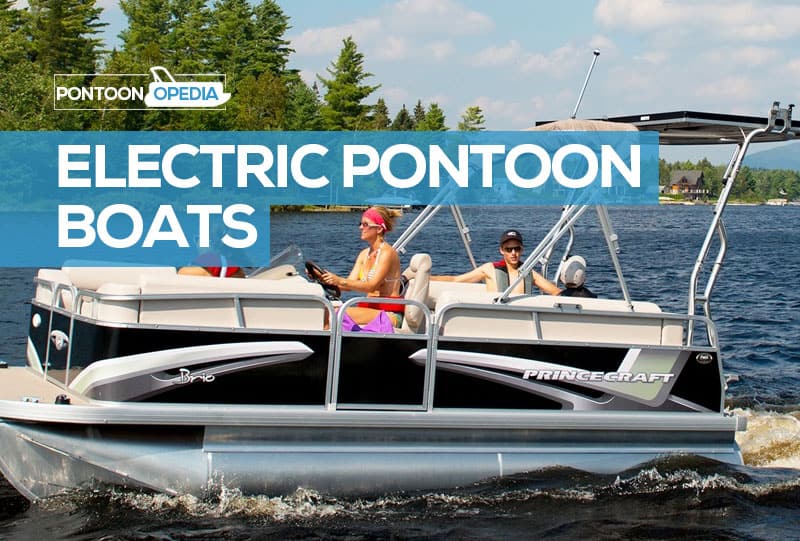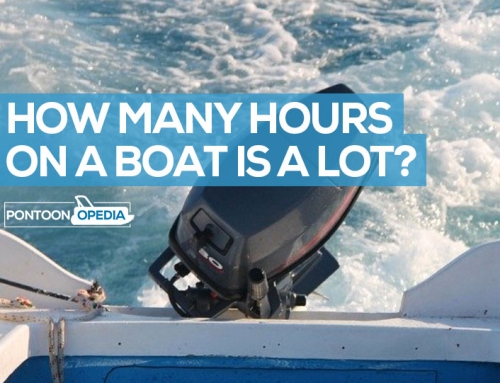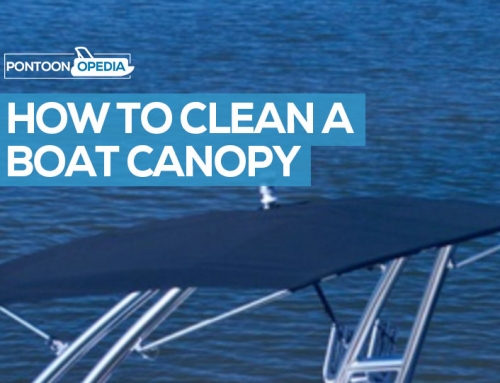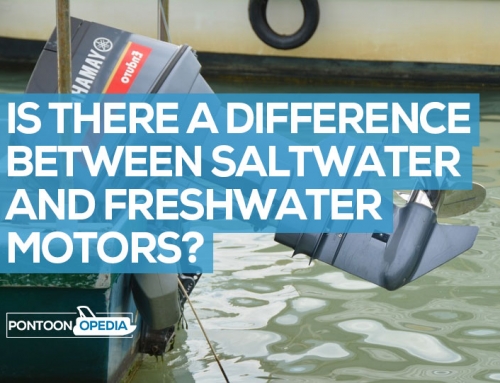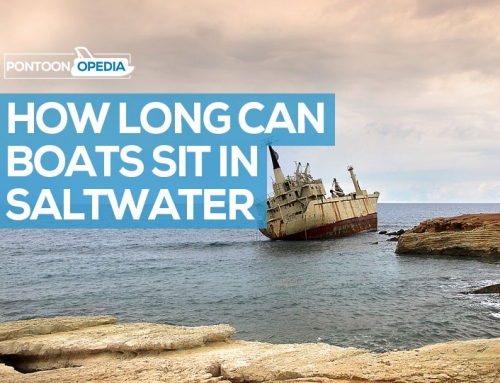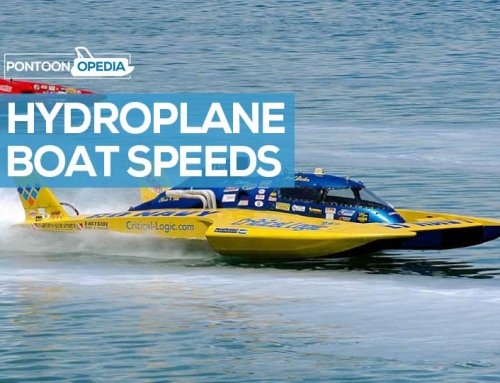Have you ever fancied owning a pontoon boat, but perhaps re-considered due to the fuel costs and environmental considerations? Or maybe certain engine types are banned on your local lakes?
More and more local jurisdictions are now putting strict environmental rulings in place, designed to keep the nation’s waterways clean for future generations. Many jurisdictions mandate that boats on their lakes only use electric boat motors.
Table of Contents
Electric motor on a pontoon boat – why?
By using an electric motor, your pontoon boat will be quieter, more environmentally-friendly, and more fuel-efficient.
You can buy electric pontoon boats that are not just both environmentally-friendly, but also budget-friendly. Some are powered by solar, others will need hooking up to a power supply before you set off.
Whilst the range isn’t massively wide yet, with only a few small electric pontoon boats available to buy, I do see this trend changing over the next 5 years.
If you do decide to install an electric motor on a pontoon boat, you will benefit from:
- Quiet motor with less noise pollution
- Clean and fuel-efficient propulsion
- Cost savings on traditional fuel and even maintenance
- No smelly exhaust fumes
- Reduction in your carbon footprint
- Less maintenance compared to a traditional motor
The leading manufacturers of pontoon boat electric motors will supply you with everything you need to get started. Most of them are simple plug and play in operation and can be working in just minutes. You can also now get hybrid options!
Below you can see some examples of what the major pontoon boat manufacturers are doing with regards to standard, small, and mini electric pontoon boats, with a little information on each one.
Princecraft electric pontoon boats
Some of the more stunning electric-powered pontoons are by Princecraft. I love the way their boats look, and you can see two examples below.
Brio-E 17
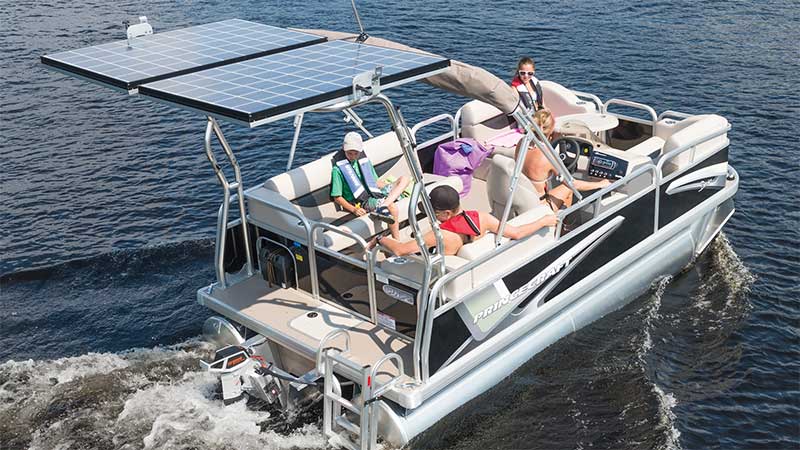
Notice how different the outboard looks on this pontoon – it’s an electric motor, not gas.
This 17-footer has a Torqeedo electric engine that can give up to 9.9 HP. You can get 7 passengers on board, and whilst it’s smaller than a typical pontoon boat, that brings a lightness which gives a little more performance than you would expect.
It’s an ideal craft for use on lakes where gas-powered engines are prohibited.
You can see it in action the video below:
Brio-E 15
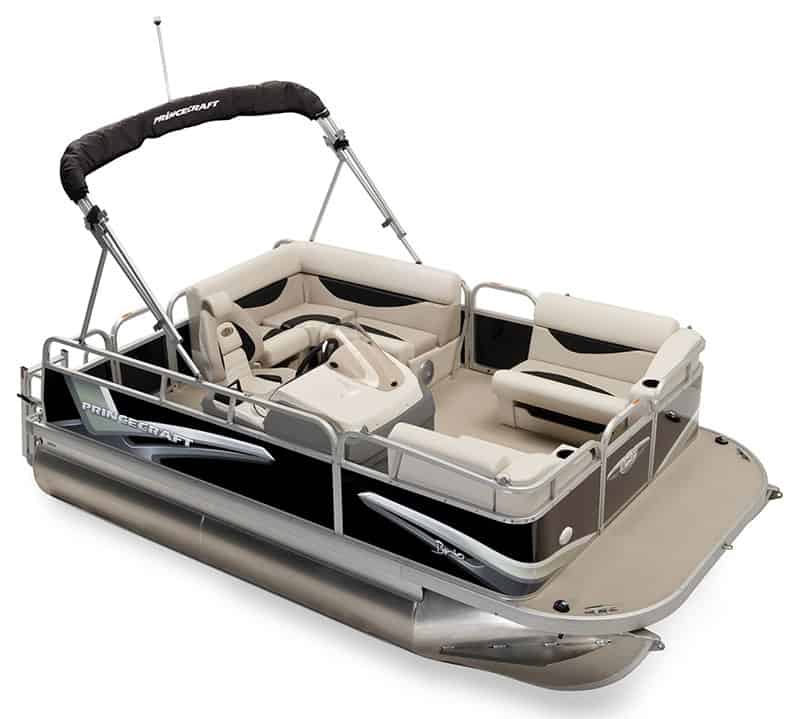
Going smaller, the 15 foot Brio-E has a very similar spec to the 17, it’s just got a shorter pontoon and deck length. It still looks awesome though, albeit it doesn’t give you a lot of room on-board for entertaining.
It says it can take 6 passengers, but that looks like it’s going to be a mighty squeeze!
What Princecraft have to say about their range:
“If you care about the environment and enjoy smaller bodies of water, the Brio-e is your kind of boat. This fully-electric pontoon runs on the sun just like you do!”
Tahoe electric pontoon boats
Tahoe offer 5 different models currently, ranging between 14 and 25 feet, so certainly aren’t small electric pontoon boats by any stretch at the latter end of the scale.
The boats listed below can be gas-powered but are designed to let you use an electric motor instead should you wish to – but you will lose a lot of power and HP.
Sport CRB/QL
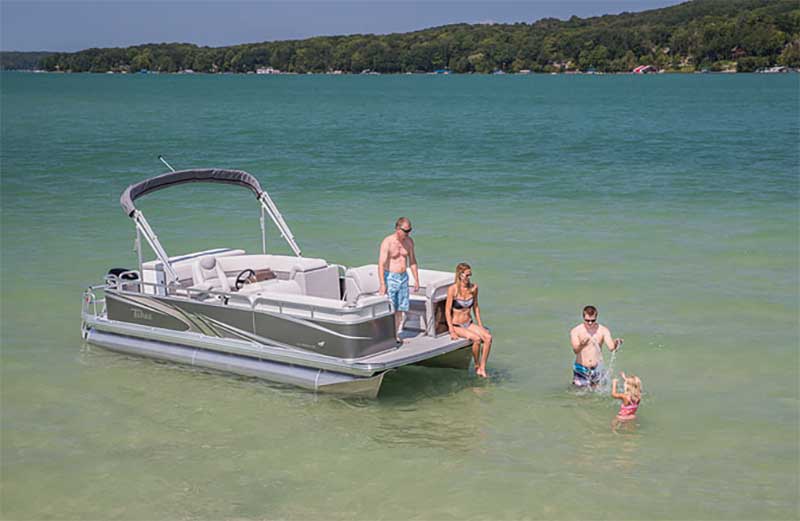
The Tahoe Sport CRB is a great family boat for all occasions.
This is a compact, small electric pontoon boat (compared to other Tahoe boats), with sizes available between 14 foot to 20 foot. Prices start at $11,900 and get up to $13,750 for the larger lengths.
It’s perfect for smaller lakes, is easy to tow, and can be gas-powered if you don’t want the electric version.
Don’t expect too much in terms of power, with HP ranging from 40 to 90 if running on gas, with the mini compact taking 5 people in total, up to 9 passengers on the longer model.
Sport Fish
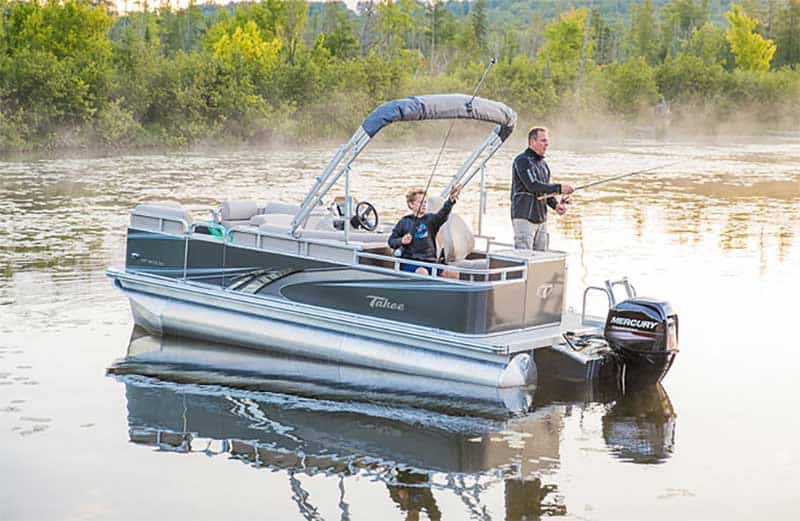
How the Tahoe Sport Fish looks, but in this image it has a gas-powered outboard, not the electric option.
The Tahoe Sport Fish also ranges 14, 16, 18 and 20-foot versions, but is a little more expensive coming in between $11,900 to $14,000 dollars.
Stylish and compact, this smaller boat is designed with fishing enthusiasts in mind with a rear fishing center, rod holders, and livewell set into the bench (like these ones).
And as you would expect from a mini-fishing pontoon, it’s has dual seats at the front so you can get the best of the catches.
GT Cruise
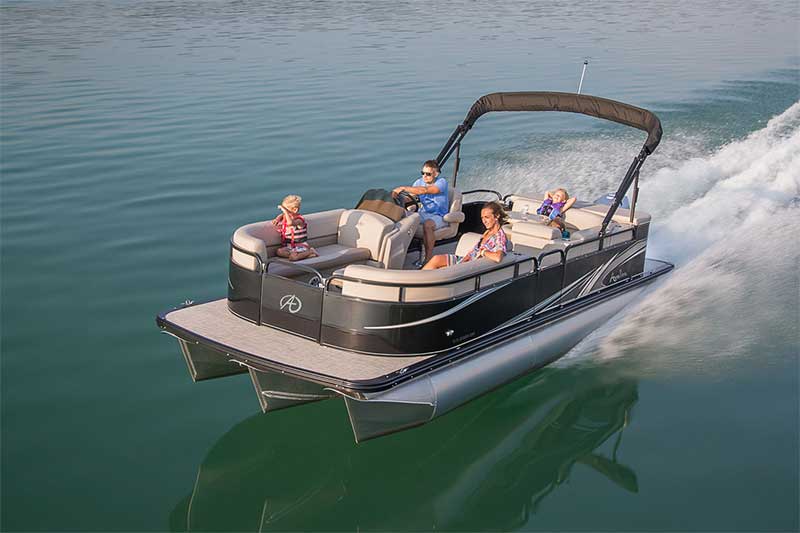
Please note: in this image the GT Cruise is depicted using the gas-outboard motor, not electric.
As you would expect from a cruiser, this boat is larger than the previous electric-powered models. Sizes range from 19 foot to 25 foot, with the longer model having 135 HP on gas and accommodating up to 13 passengers.
It’s practical, affordable (relatively-speaking) with prices from $13,700 to $18,000 and has more luxurious comfort features compared to the previous two models.
GT Fish
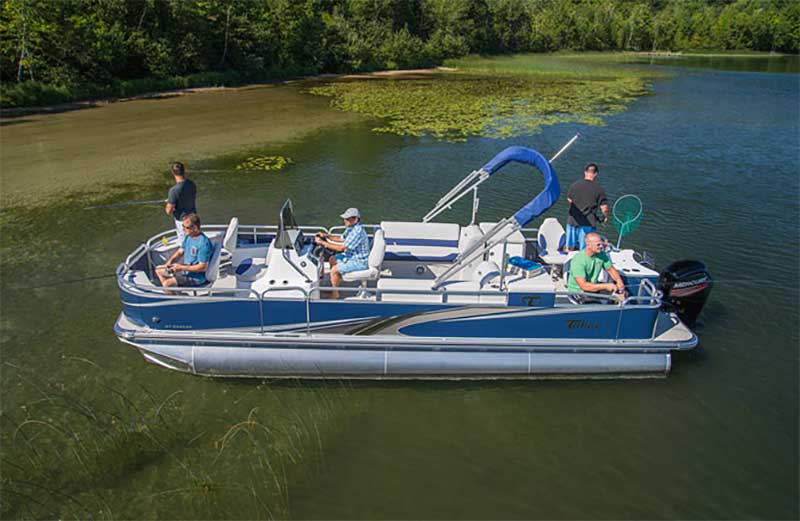
In this photo the GT Fish is shown with a gas-powered outboard motor.
The GT Fish is available in 3 different fishing set-up configurations, and 4 sizes (19, 21, 23, and 25 foot). It’s a beautiful fishing pontoon but will lose a lot of its power if you decide to go down the electric route.
The Quad Fish and Center Console Fish configurations have double seating at rear and front, making for excellent fishing trip options with parties up to 13 in size.
GT Quad Lounge
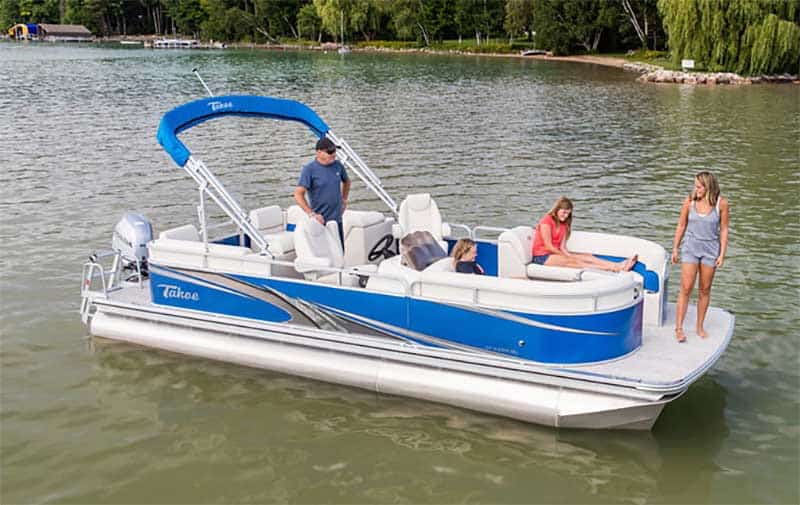
As with the other Tahoe images, I couldn’t source one showing the electric motor pontoon boat in place.
In two sizes, 23-foot and 25-foot, the GT Quad Lounge is Tahoe’s premium pontoon that can be electrically powered. It comes with 4 large benches, so it’s the entertainer amongst all the other models.
What Tahoe say about their electric pontoon boats:
“Turn your Tahoe into an electric pontoon boat for use on smaller or shallow lakes, or lakes where internal combustion engines are prohibited. Electric motors on pontoon boats are environmentally and budget friendly, as they don’t require ongoing fuel costs. The following Tahoe pontoon boats accommodate electric engines.”
Southland electric pontoon boats
Southland’s range certainly fall into the category of mini electric pontoon boats and are more typical of what you would expect in this niche. Check them out in the photo below.
Unfortunately, I have no pricing information on these smaller models, as costs are upon request.
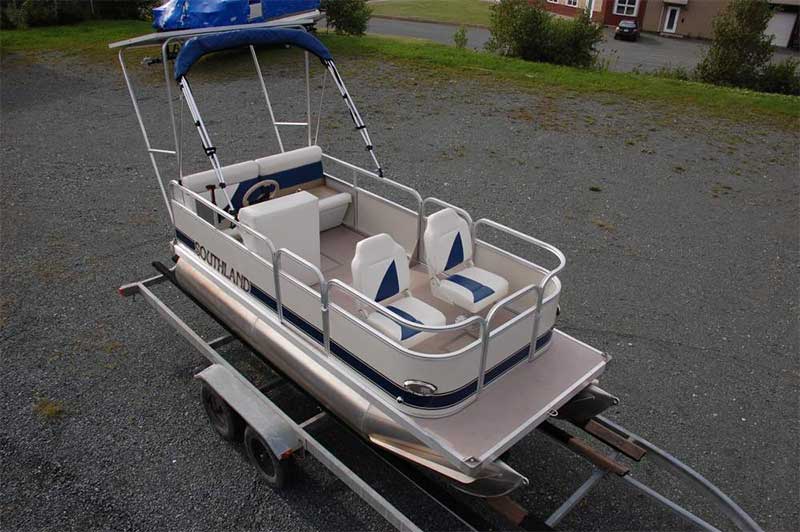
It’s small, but perfectly formed, running on electric power.
What Southland say about their electric pontoon boats:
“Because we care about nature respect and because regular gas prices increase are a cruel reality, Southland Boat provides you electric powered solutions.We can say that due to his natural lightness, the pontoon boat is the perfect tool to use with electric outboard. It’s for the reason why, Southland Boat, offers you electric outboard available in 10 hp, 12 hp and 25 hp equivalent power with 2 years warranty.”
What types of electric motors for pontoon boats are there?
Currently there are 4 different types of electric power motors that can be used with pontoon boats.
#1: Electric trolling motors
These smaller electric motors on pontoon boats aren’t designed to get you onto the plane or for primary propulsion, expect for when used on very small, compact mini pontoons.
You mount them on the fore or aft of your boat, and are typically used when fishing, giving the skipper the ability to slowly move through the water using hand, pedal, or remote controls.
#2: Electric outboard motors
When people think of electric pontoon boats, this is usually the type of motor that they will envisage.
They look almost the same as a gas-powered outboard motor but will be smaller. Essentially the operation is the same as a gas outboard, with power tilt and steering wheel connection – the main difference being the connection to the charge in the boat.
#3: Trim tab mounted electric motors
Trim tab motors are controlled via a joystick, which moves one forward and one backwards from their positions mounted to the rear of each pontoon tube.
The benefit to having trim tab motors is that you can turn the pontoon almost on a dime in one place, as one motor goes one way, the other another, creating an almost stand still turn ability.
They can be fitted in-partnership with a standard outboard if required.
#4: Cavitation plate mounted electric motors
This set-up works kind of like a hybrid motor vehicle does, with the electric motor being fitted to the cavitation plate of your existing gas-powered outboard.
That lets you switch between gas and electric, giving you the ability to drive your pontoon quietly in electric mode, but switch to gas when the need demands it.
How fast do electric pontoon boats go?
This is the kicker. Currently small electric pontoon boats aren’t going to give you a lot of speed. For example, those horse power ratings you saw on the Tahoe Pontoons earlier in the article are if you have the gas-powered outboard.
You won’t get the same performance currently from an electric motor.
Expect to have speeds of between 2 and 10 miles per hour when running a small boat on electric, but I wouldn’t be surprised to see speeds of 20 miles per hour coming very soon, due to technological advances.
For a data chart showing the average speeds of some of the top pontoons, read this guide to how fast your boat could go with a classic outboard motor.
How long will batteries last?
If travelling at top speeds, you might get between 2 and 4 hours of battery life, extending to 4 to 8 hours when averaging low-end speeds.
Are electric boats the future?
Great question, and I believe that as with all recreational vehicles, the move to fully-electric is inevitable. Whilst the performance isn’t there now, that is bound to change over the next half century.
The reason we aren’t all riding around on electric powered boats at the moment is down to one main factor, and that’s battery life.
A spokesman for Atlantic Cruising had this to say in a great article posted in 2017:
“With the current technology, batteries have roughly 1/20 of the energy content of diesel fuel. This means diesel fuel delivers 5 to 6 times more energy than modern batteries – pound for pound. Bottom line? Yes, electric motors are coming, but the technology is nowhere near ready for prime time yet. In 50 years? Absolutely. Sooner? Not in the immediate future.”
Benefits of an electric pontoon boat
- Cleaner and quieter with less noise pollution
- More fuel-efficient with cost-savings
- Less spend on expensive maintenance
- No exhaust fumes
- Reduced carbon footprint
- Lower overall cost of ownership
Negatives to an electric pontoon boat
- Low speeds and low power
- Low battery life and the need to re-charge
- Electricity and water don’t mix well
The Real Cost of Electric Pontoon Boats
You should also be aware that while an electric motor for your pontoon boat will initially cost you almost three times that of a diesel-powered motor, in the long run, you’ll likely save quite a bit of cash!
Now, that doesn’t mean there aren’t ongoing costs to be aware of. While you won’t be spending money on fuel (which is certainly one of the most expensive aspects of boating), you will still need to spend some cash in order to keep your electric motor functioning properly.
The rule of thumb for all motors is that it needs to be serviced after every 100 miles of use.
However, depending on where you live, it may be challenging to find a mechanic who understands your electric motor. Therefore, you will likely pay a bit more during serving in order to find a specialist.
In the same way, the electric motor still needs to be maintained, and the battery certainly won’t last forever.
As well, the worst possible case scenario is that your electric motor completely breaks due to overuse, water-related issues, or a simple malfunction. In that case, if you don’t get significant use out of the expensive motor, buying a new one can be seriously frustrating.
Overall, we really don’t know how much it costs to maintain an electric motor over time as no one has had one for very long. So while experts guess that it will be less expensive than a diesel motor, it’s still a bit of a guessing game as to how much you’ll really spend.
The last word…
If you own a pontoon boat, you will know very well how expensive the cost of ownership can be. In fact, here are some notes I put together detailing the types of costs you might incur over a 12-month period.
But if it is leisurely cruising and trolling that floats your boat, an electric powered pontoon boat could be just the ticket – but right now, you’re not really going to get anything decent at a reasonable size.
Electric pontoons are only really viable as the very small fishing boats. If you take an electric outboard and put it on your 25-footer, you are probably going to be really disappointed. And you can kiss goodbye to pontoon water sports and tube towing!
However, it will save you money. It will help to protect the environment. And it will let you ride the water knowing your pollution free and reducing your carbon footprint.
Right now, I don’t think that electric motors suit what most pontooners want from their boat which is decent speed, decent pulling power.
Wait a few years though, and things could be very different!

